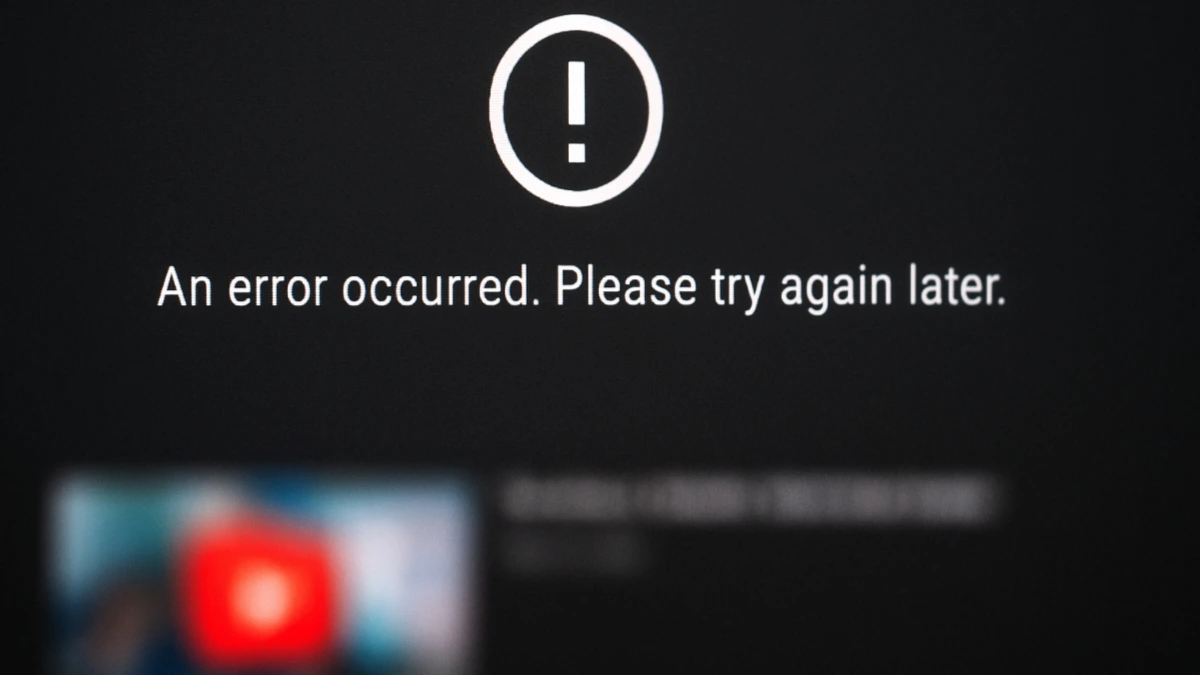A major YouTube outage disrupted video streaming for millions of users on Wednesday afternoon across the United States and Europe, leaving viewers unable to play content on the world’s largest video-sharing platform.
Users attempting to watch videos on desktop browsers encountered the message “An error occurred. Please try again later,” while those using mobile apps saw the notice “Something went wrong.” The website’s browsing and search features remained operational, but videos failed to load once selected.
Streaming through YouTube Music was also impacted, with users unable to play songs online. However, downloaded offline content continued to function normally.
YouTube, a subsidiary of Alphabet Inc., serves more than two billion monthly users and handles billions of video views each day. The platform’s reliability is crucial not only for entertainment but also for education, live news coverage, and business marketing.
Although YouTube rarely experiences extended disruptions, even short outages can have widespread ripple effects. In previous years, brief technical faults led to spikes in complaints across social media and outage monitoring sites.
On Wednesday, outage tracking services such as DownDetector recorded thousands of reports within minutes of the issue surfacing, suggesting a large scale technical failure.
Early indications pointed to possible problems with YouTube’s video delivery infrastructure rather than general internet service providers or user devices.
Google had not issued an official statement by late afternoon Pacific Time, but several engineers familiar with cloud based video networks said the issue appeared to be “systemic” rather than localized.
Technology analysts and network experts noted that large-scale failures of this kind often originate from issues in data centers, routing systems, or content delivery networks the backbone infrastructure that moves videos across the globe.
“It looks like a widespread backend failure, potentially linked to a content delivery misconfiguration,” said Dr. Maria Chen, a digital infrastructure researcher at the Internet Resilience Institute.
“When these systems go down, it can disrupt access for millions of users simultaneously, even if the website itself still loads.”
A former YouTube engineer, speaking anonymously due to company restrictions, said that such outages often occur after internal updates or network balancing changes.
“Sometimes, a minor software adjustment can cascade into major delivery errors if the routing system doesn’t sync correctly,” the engineer said.
Another industry expert, Kevin Ramirez, a cybersecurity consultant based in San Francisco, added that video services like YouTube depend on multiple interlinked servers worldwide.
A single regional failure can have a global impact within seconds, he said. “Even with redundancy measures in place, diagnosing the root cause quickly is extremely challenging.”
Outage maps from DownDetector and NetBlocks showed the majority of user reports coming from the US & UK, Germany, France, and the Netherlands, with smaller clusters in parts of Asia and the Middle East.
More than 5,000 outage reports were logged in the US within the first hour, while Europe recorded several thousand more. By comparison, a previous YouTube service disruption in mid 2025 generated similar complaint volumes in roughly the same time frame.
Unlike this week’s failure, earlier outages had been linked to brief Google Cloud configuration errors. This time, the problem seemed confined to YouTube’s streaming pipeline, as other Google services including Gmail, Maps, and Drive were operating normally.
Frustration spread quickly among creators, educators, and casual viewers. “I thought it was my WiFi at first,” said Alyssa Jimenez, a content creator based in Seattle.
Then I noticed all my subscribers were messaging me that nothing was playing. It’s nerve-wracking when your main source of income goes dark unexpectedly.
In London, university librarian Omar Patel said his team relies on YouTube for educational videos and recorded lectures.
“We were in the middle of a class demonstration when everything froze,” he said. “It’s a reminder of how dependent we’ve become on a single platform for digital learning.”
From Berlin, student Lena Fischer described the experience as disruptive but familiar. “I tried restarting my phone and clearing the app cache, but it didn’t help,” she said. “At least this time, it’s not just me the entire campus couldn’t load a single video.”
Industry analysts believe YouTube engineers are already working to restore normal streaming operations. In similar past cases, partial service resumed within a few hours as traffic was rerouted through alternative data centers.
Experts also expect the company to conduct an internal review of its redundancy systems and load balancing mechanisms to prevent similar incidents in the future.
“Every major platform learns from these failures,” said Dr. Chen. “You’ll likely see YouTube enhance its failover architecture and improve its monitoring tools after this.”
There may also be renewed discussions among regulators about infrastructure transparency, given YouTube’s critical role in global information sharing and emergency communication.
As of Wednesday evening Pacific Time, YouTube remained inaccessible for video playback across several regions, though some users reported gradual recovery in isolated areas. Other Google services appeared unaffected.
While the outage disrupted entertainment, education, and business workflows worldwide, experts said such incidents highlight both the scale and fragility of global digital networks.
The incident underscores a broader reality of modern life in a world increasingly reliant on cloud based platforms, even a brief technical failure can silence billions of screens and remind users just how central YouTube has become to everyday communication.

